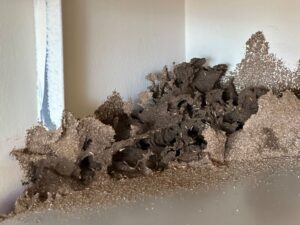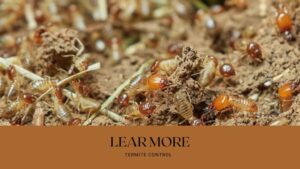Regular Termite Inspections Is a Must
As a homeowner in Sydney, you're likely aware of the threat termites pose to your property. These wood-eating pests can cause significant damage, and their presence in your home can lead to costly repairs. But did you know that regular termite inspections can help you avoid these expenses? By catching an infestation early, you can prevent major destruction and protect your most valuable investment. In this article, we'll explore the importance of regular termite inspections for Sydney homeowners like you.
The Importance of Regular Termite Inspections
For homeowners in Sydney, regular termite inspections are crucial to protect their most valuable investment from the devastating effects of termite damage.
Why Termites are a Threat to Sydney Homes
To put it simply, termites love the hot and humid climate of Sydney, and they can cause significant damage to homes if left unchecked. With millions of dollars in damage each year, it's vital to take proactive measures to prevent termite infestations.
The Consequences of Not Having Regular Inspections
Importance cannot be overstated when it comes to regular termite inspections. Without them, you may not detect an infestation until it's too late, and the damage is already done.
The consequences of not having regular inspections can be severe. Termites can cause significant structural damage to your home, leading to costly repairs that can run into tens or even hundreds of thousands of dollars. Moreover, unaddressed termite damage can reduce your home's value and curb appeal, making it harder to sell. By the time you notice visible signs of damage, the colony has likely been active for years, and the damage may be extensive. Regular inspections can help detect termite activity early, preventing costly repairs and ensuring your home retains its value.
Signs of a Termite Infestation in Your Home
Some telltale signs to look for include:
Visible Damage

For instance, sagging wallpaper, wood that sounds hollow when tapped, or visible frass (termite droppings) around wood. Termites prefer damp, dark places like wall cavities and crawl spaces.
Mud Tubes and Other Signs
Homeowners should also be on the lookout for mud tubes along foundations, pipes, siding, or fences. Termites build these to stay moist as they travel to a food source.
Visible signs of termite activity, such as mud tubes, are often the most obvious indication of an infestation. However, it's crucial to remember that termites can cause significant damage before these signs become apparent.
Swarmers and Frass
Signs of termite activity can also include swarmers, the winged termites that emerge from nests. Seeing swarmers, especially around lights at night, often means an active infestation.
For instance, if you notice a swarm of termites around your home, it's likely that an infestation is already underway. Similarly, finding frass, or termite droppings, near wood or other cellulose materials can indicate termite activity.
The High Cost of Termite Damage if Left Untreated
All homeowners in Sydney should be aware of the devastating consequences of termite damage if left untreated. The financial burden of repairing or rebuilding due to uncontrolled termite infestation can be staggering, with average costs exceeding $50,000. In contrast, regular termite inspections and preventative treatments are relatively low-cost, typically starting at around $3,000 per year.
Expensive Repairs
To put it bluntly, termites can cause catastrophic structural damage to your home by devouring wood and cellulose materials. If left untreated, repairing this damage often requires extensive renovations involving removing and replacing damaged wood, which can cost tens or even hundreds of thousands of dollars. In severe cases of long-term infestation, major rebuilding may be necessary.
Lower Property Value
Expensive repairs are not the only consequence of termite damage. Unaddressed termite damage also reduces your home's value and curb appeal. When it's time to sell, potential buyers will likely demand repairs or lower offers upon seeing signs of damage.
Termite damage can significantly impact your home's resale value. Buyers may be deterred by the prospect of costly repairs, leading to lower offers or even a failed sale. By investing in regular termite inspections and preventative treatments, you can ensure your home retains its value and attracts the best offers when the time comes to sell.
Prevention is Key
Despite the potential for devastating damage, termite infestations can be prevented with regular inspections and proactive measures. As a homeowner in Sydney, it's vital to take a proactive approach to termite control to avoid the financial burden of repairs and protect your most valuable investment.
The Cost-Effectiveness of Prevention
Preventing termite damage is significantly more cost-effective than repairing the damage after the fact. With professional termite control services starting at around $1250 – $4500 for an average home, the investment in prevention is a fraction of the potential repair costs, which can exceed $50,000.
Professional Termite Control Services
To ensure the best possible protection for your home, it's crucial to work with a reputable pest control expert who can provide regular inspections, monitoring, and preventative treatments. By partnering with a professional, you can rest assured that your home is being protected from the threat of termites.
It's vital to remember that professional termite control services are not a one-time fix, but rather an ongoing process that requires regular maintenance and monitoring. By committing to regular inspections and treatments, you can ensure that your home remains termite-free and retains its value over time.
Regular Inspections: The Key to Preventing Termite Infestations
 To ensure your Sydney home remains safe from termite damage, regular inspections are imperative. By detecting termite activity early, you can avoid costly repairs and protect your most valuable investment.
To ensure your Sydney home remains safe from termite damage, regular inspections are imperative. By detecting termite activity early, you can avoid costly repairs and protect your most valuable investment.
Schedule Annual Inspections
Preventing termite infestations starts with scheduling annual inspections with a reputable pest control company. This ensures that any termite activity is caught early, and you can take prompt action to eliminate the problem before it escalates.
Early Detection is Critical
With early detection, you can avoid the devastating consequences of termite damage. Termites can cause significant structural damage to your home, leading to costly repairs and a reduction in your property's value.
Plus, the longer you wait to address a termite infestation, the more extensive the damage will be. By catching termite activity early, you can limit the damage and avoid costly repairs.
Treating an Active Infestation
For homeowners who have already fallen victim to a termite infestation, prompt treatment is imperative. Your pest control expert can treat the infestation using either barrier or baiting systems, depending on the severity of the infestation.
Inspections are crucial in determining the best course of treatment. By identifying the extent of the infestation, your pest control expert can develop a targeted treatment plan to eliminate the termite colony and prevent future infestations.
What Attracts Termites to a Home?
Many homeowners are unaware of the factors that attract termites to their homes. Understanding these attractants is crucial in preventing costly termite damage.
Moisture
With excess moisture, termites can thrive and multiply quickly. Leaky pipes, poor drainage, wood in contact with soil, and condensation all provide the damp conditions termites seek. Fix any leaks, improve drainage, and ventilate crawl spaces to eliminate access to moisture.
Wood Debris
One of the most common attractants for termites is wood debris. Wood chips, mulch, tree stumps, and any untreated wood in contact with the soil are open invitations for termites to infest your home. Clear your yard of any wood debris within a few feet of the foundation.
Attracts termites like a magnet, wood debris provides a readily available food source for these pests. By removing wood debris, you're taking away a potential attractant and reducing the risk of termite infestation.
Hidden Entry Points
An often-overlooked factor is hidden entry points. Small cracks in foundations, openings around pipes, gaps under siding, and holes in roofs all provide concealed access for termites to enter a home unseen. Seal any visible cracks or holes to eliminate entry points.
Hills District homes are particularly vulnerable to hidden entry points due to the region's subtropical climate. By sealing these entry points, you're preventing termites from gaining access to your home and reducing the risk of infestation.
Food Sources
Sources of food are abundant, making it an ideal environment for termites. Any untreated wood, wood siding, wood mulch, cardboard, or paper products in contact with the ground can act as a food source to attract termites. Eliminate wood-to-ground contact and ventilate areas where cellulose materials are stored.
What makes food sources so appealing to termites is the abundance of cellulose, a key component of wood and plant-based materials. By removing or treating these food sources, you're reducing the attractiveness of your home to termites.
Shelter Tubes
Termites construct shelter tubes to travel between the ground and your home, providing them with protection and moisture. Destroy any mud tubes found on foundations to remove access routes into the home.
Wood is a natural attractant for termites, and shelter tubes provide them with a safe passage to reach their food source. By destroying these tubes, you're disrupting the termite's ability to access your home and reducing the risk of infestation.
Why Termites Love Homes In The Hills District
Keep in mind that homes, with raised floors and ample crawlspace, are a dream come true for termites. Here are a few reasons why termites find these homes so appealing:
Accessibility
For Sydney homes, the open areas under the house make it easy for termites to access the floor joists and wooden supports. Once they've entered the crawlspace, termites have a direct path to feast on the wood in your home's structure.
Moisture
With the humidity and occasional flooding common in Queensland, termites have a constant source of moisture. Termites require a constant source of moisture, and the crawlspace of a Queenslander home serves as the perfect environment.
Love the fact that termites thrive in moist environments, and the crawlspace of a Queenslander home provides the ideal conditions. Installing a vapour barrier and improving ventilation can make the area less hospitable for termites.
Wood Debris
For pieces of wood, tree roots, and other cellulose materials are often left behind under homes during construction. These provide a ready food source for termites to feed on before moving on to damage your home.
Termites are drawn to wood debris like magnets, and the crawlspace of a home can be a treasure trove of cellulose materials. A professional pest control expert can remove wood debris and treat the soil during initial termite control and prevention.
Final Words
Presently, you're equipped with the knowledge to protect your Sydney home from the devastating effects of termite infestations. Bear in mind, regular termite inspections are the key to avoiding costly repairs and preserving your home's value. Don't wait until it's too late; schedule a professional termite inspection today and enjoy the peace of mind that comes with knowing your home is safe from these wood-eating pests.
Get in touch with the team at So Pest Off
So Pest Off – Pest Control
https://sopestoff.com.au/
The Article The Importance Of Termite Inspections For Sydney Home Owners First Appeared ON
: https://ad4sc.com
The Article The Importance Of Termite Inspections For Sydney Home Owners Was Found On https://limitsofstrategy.com
Comments are closed